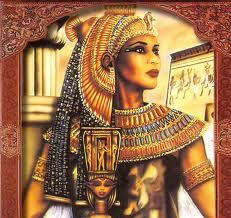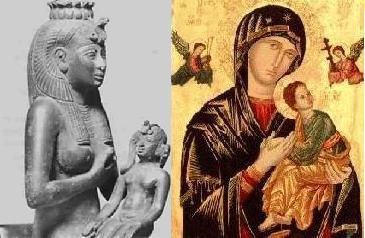
Originally, I was just going make a single post discussing the differences between Isis and Aset (Don’t worry, I’m still going to do this) and then leave it at that. However, I decided why not turn it into a series? “Getting to Know the Netjeru” is going to cover some of the Kemetic gods and goddesses (Nerjer and Netjert respectively). I figure I’ll look at some of the mythology along with how the ancient Egyptians saw and worshiped Them. I’ll also cover how modern Kemetics can honor Them today.

Part 1 of Series: Isis or Aset?
Isis is actually the reason I’m writing this blog in the first place. She inspired me to read about Egypt which eventually led me to discover Kemetics. Of course I had heard of Her before, I imagine in school at some point, but I didn’t know anything about Her. Because of that fact I had probably never thought about Her or Egypt, I decided the dream She came to me in was something far more than my subconscious’ creativity. My dream of Isis was the beginning of this journey.
I soon learned that there was more to the story than what appeared on the surface. Isis was not only known in Egypt, but in much of the ancient Greco-Roman world. Isis was not even Her original name. Aset, the Egyptian goddess, is the origin of the more commonly known Roman goddess Isis. Aren’t they the same, though? That’s what I thought at first. Upon further study, I’ve discovered the answer is more complex than I could have imagined.
As I write this, I’m not sure if they are the same goddess with two different aspects or if they are two completely different goddesses. I think in order to come up with a personal opinion, one should know of Her history and mythology.
We can see Aset mentioned as early as the Fifth Dynasty, 2494 - 2345 PCE (pre common are, a.k.a before Christ), in the Pyramid Texts, 4th Utterance:
"Recitation by Nut: O King, I have given to you your sister Aset, that she may lay hold of you and give to you your heart for your body."This is only the first written mention of Aset; the actual origins of Her are uncertain. The research I’ve done suggests Aset has been worshiped as early as 3100 PCE, but I can find no legitimate source for this. If anyone has any documented source of the first appearance of Aset let me know. However, 2494 PCE is still fairly early as far as documented history goes. Moving onward…
Aset, or Uset, is considered to be the actual name Egyptians used. It is uncertain though, of the correct pronunciation. The meaning of Her name is said to mean “She of the throne”. Actually, Aset in hieroglyphics contains the symbol of a chair, or throne.
The mythology surrounding Aset varies, with many different stories and versions of them. However, they have their similarities. The most familiar story is that of Aset and Her brother/consort Osiris (Ausir or Wesir). Aset and Ausir were siblings, along with Nephthys and Set (Nebt-het and Seth respectively). Their parents were Nut and Geb, the sky goddess and the earth god.
One story says that Aset gained her power from learning the secret name of Ra. Egyptians believed that words, both written and spoken, contained immense importance and magic. If you were to know a person’s “secret” name, or real name, you held power over them. Knowing this, Aset fashioned a snake from Ra’s spit and left it in his path so he would be bitten.
After the snake had attacked him, he laid in agony. Aset told him she had the cure, but she would only do it in exchange for his secret name. At first, he refused, but eventually the pain was so excruciating that he had no choice. He finally told her the name and in turn she cured him. Aset became known as great magician after she inherited Ra’s power.
Another story that most people are familiar with is that of Aset and Osiris’ love. There are many versions of the story, but all tend to go like this. Jealous of Osiris’ reign of the kingdom, he was murdered by his own brother, Seth. Seth chopped the body of Osiris into pieces and scattered them throughout Egypt. Aset was overwhelmed by immense grief for the loss of her brother and husband. Aset set out to search for the pieces of her beloved, some stories say that Nephthys went with her. Eventually she found all the pieces but one, his member. It is said that she fashioned a member out of gold, other say it was clay, and others say that she indeed did find all the pieces of his body. Either way, she managed to make him whole once more, and it was in this way she conceived Horus, her son.
This story has many powerful themes; death, love, magick, rebirth, loss, healing, and new life. When we explore the mythology of Aset one can see the many forms she takes; wife, mother, lover, grief-stricken wife, and magician. It is true that she is one of the most versatile of the Egyptians gods and goddesses. Sometimes she is known as Aset of A Thousand Names.
She is known as a fierce, protective goddess. Yet at the same time, she is benevolent and kind. She answers the prayers of royalty and also of the poor. She is a goddess belonging to no people or group in particular. She is often pictured with wings, protecting all that she surrounds. In one dream I had of Her, my subconscious described Isis as “all-encompassing” and “enfolding”. Indeed, it is comforting to imagine Aset wrapping Her wings around that which She protects, keeping it from all harm.
It was during Alexander’s conquest of Egypt that allowed Aset to become known outside of her home land. Aset then became Isis; Isis being the Greek translation of her Egyptian name. Temples spread throughout the Greco-Roman world. Temples were built in Pompeii, Philae, Byblos, Delos, and more spreading out into the land modernly known as the Middle East.
In the Hellenic world, Isis was the ideal wife and mother. She was representative of the moon, a protectress of sailors and seamen, a friend to the needy, a fertility goddess, and much more. It seems though that somewhere between Egypt and the Roman world, she lost the fierceness she originally had. She became “softer” it seems, for lack of a better term.
Even though certain aspects and mythology stayed the same, we can see the differences between Aset and Isis. Does this make Isis a completely different goddess? Or is Isis just the way the Romans saw Aset? Humans perceive things differently and the Roman culture was so different from that of the Egyptians that it would make sense for them to shape Isis to fit in more with their traditions.
In modern day Kemetics, this is still a big question. I’m not sure which way I see Her, but I think it’s important to acknowledge her in all her aspects and versatility. Like humans, god are not just their outside appearance, but instead much more. One of Isis’ Roman titles was “Queen of Heaven” and once can in fact notice the similarities between the Black Madonna and the artwork showing Isis nursing a young Horus. It could even be said that the Catholic Madonna has origins in Egypt. With this information we could say that Aset has three forms instead of two.

Aset compared to the Christian Mary
It can be confusing to try and comprehend this, but that is monolarity. One goddess with many forms, and many goddesses with one form. Perhaps they are all one in the same and completely different at the same time. Would She be offended if you honored Isis and not Aset? Prayed to the Madonna, but not Aset or Isis? I don’t think so. I don’t believe that She is a jealous goddess. Our deities understand our needs. At times we might need a mother and not a magician. Or perhaps at times we need to be strong to deal with our hardships, praying to the independent and ferocious Aset. Then again we have moments where we seek transformation and healing, restoration from loss. It is then that we envoke the qualities of all three.
So where does the answer lie? I honestly believe it comes down to each person’s opinion. Why not try to get to know the Goddess Herself? Talk to her, meditate upon her, honor her in ritual. Modern Kemetics believe it is necessary to build a relationship with the Netjeru, for it is the foundation of our faith, is it not?
If you find yourself still wondering who She really is, ask Her yourself. :)
Sources used:
R.O. Faulkner,
Even though certain aspects and mythology stayed the same, we can see the differences between Aset and Isis. Does this make Isis a completely different goddess? Or is Isis just the way the Romans saw Aset? Humans perceive things differently and the Roman culture was so different from that of the Egyptians that it would make sense for them to shape Isis to fit in more with their traditions.
In modern day Kemetics, this is still a big question. I’m not sure which way I see Her, but I think it’s important to acknowledge her in all her aspects and versatility. Like humans, god are not just their outside appearance, but instead much more. One of Isis’ Roman titles was “Queen of Heaven” and once can in fact notice the similarities between the Black Madonna and the artwork showing Isis nursing a young Horus. It could even be said that the Catholic Madonna has origins in Egypt. With this information we could say that Aset has three forms instead of two.

It can be confusing to try and comprehend this, but that is monolarity. One goddess with many forms, and many goddesses with one form. Perhaps they are all one in the same and completely different at the same time. Would She be offended if you honored Isis and not Aset? Prayed to the Madonna, but not Aset or Isis? I don’t think so. I don’t believe that She is a jealous goddess. Our deities understand our needs. At times we might need a mother and not a magician. Or perhaps at times we need to be strong to deal with our hardships, praying to the independent and ferocious Aset. Then again we have moments where we seek transformation and healing, restoration from loss. It is then that we envoke the qualities of all three.
So where does the answer lie? I honestly believe it comes down to each person’s opinion. Why not try to get to know the Goddess Herself? Talk to her, meditate upon her, honor her in ritual. Modern Kemetics believe it is necessary to build a relationship with the Netjeru, for it is the foundation of our faith, is it not?
If you find yourself still wondering who She really is, ask Her yourself. :)
Sources used:
R.O. Faulkner,
The Ancient Egyptian Pyramid Texts,
Digireads.com Publishing, 2007
Patricia Monaghan,
Patricia Monaghan,
The Goddess Path Llewellyn Publishing, 1999
Image of Isis/Horus and Mary/Jesus from Webster’s Online Dictionary,
Image of Isis/Horus and Mary/Jesus from Webster’s Online Dictionary,

Δεν υπάρχουν σχόλια:
Δημοσίευση σχολίου